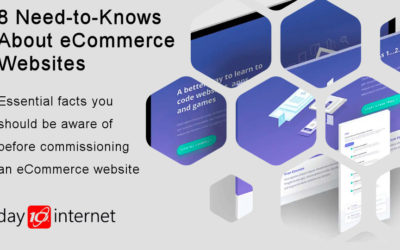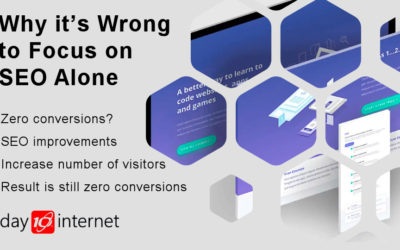If you are a business owner, a sole trader, or a marketing executive and ever had the task of getting a website designed and built for your business, then you will know that it is not one to be taken lightly. Most people don’t know where to start. It can be like finding yourself in a pitch-black room, groping around trying to find a way out.
But it needn’t be like that if you follow the advice I’m going to give you here. Follow the steps I describe, and you will have laid the foundations that will see you through the entire process and get well-designed website completed and delivering for your business.
Before going any further, before even finding a suitable web designer, you need to create a design brief. This is your blueprint that will guide you through the entire process. Without it, you will be adrift at sea, not knowing where you are going or where you will end up. And you will be at the mercy of anyone who wants to take advantage of you along the way.
A design brief provides a detailed description of what you want your website to look like, what it should do, and who it should target. A well-crafted design brief can help you avoid miscommunications with your designer and ensure that you end up with a website that meets your expectations.
In this article, I will guide you through the steps to create a website design brief that will help you communicate your vision to your designer and get the website you want.
Step 1: Define Your Goals
The first step in creating a design brief is to define your goals for the website. What do you want the website to achieve?
Do you want to generate more leads or sales? Do you want to build brand awareness – just make people aware of your business in other words? Do you want to provide information to your customers? Do you want to sell products or services online?
You wouldn’t buy a car without knowing what you’re going to use it for. Running around town or commuting long distances? Carrying just two people or your entire family plus luggage? These types of decisions will determine what you buy and how much you will spend.
Your goals will help to guide the design of the website and determine its functionality.
Step 2: Identify Your Target Audience
The second step in creating a design brief is to identify your target audience.
Who is your website for? This is often the most difficult step for most business owners, and it is one of the most important. Get this wrong and the rest of your brief will be off course.
Your target audience may not be the most obvious, so you need to think this through carefully.
Examples of target markets that are not always obvious.
1. Children’s movies: While children are the obvious target audience for these movies they often appeal to adults as well. For example, the Pixar movie “Inside Out” deals with complex emotions and mental health in a way that can resonate with viewers of all ages. Most of the time, adults are paying and so they are the real targets.
2. Luxury products: Luxury products are often marketed to wealthy individuals, but they can also appeal to those who aspire to a luxurious lifestyle and are prepared to sacrifice other purchases to acquire them. These people may provide a bigger revenue stream that the wealthy individuals and, as such, can be the primary target audience.
Once, you’ve decided on your primary target audience, decide what are their interests and preferences. What drives them? How much are they likely to pay? Where do they reside? The more detail you can give about them the clearer you will become. It’s like searching for something with a telescope and then gradually getting it into focus.
Understand your audience and it will help you get a website created that will resonate with them and meets their needs.
Step 3: Determine Your Branding
The third step in creating a design brief is to determine your branding.
What colours, fonts, and imagery represent your brand? If you’re coming into this process cold, you may want to look around at your competitors’ branding to get some ideas.
The colours and styles you use should be in keeping with type of industry your company is in. For example, if you’re in the environmental sector, you want to use colours that reflect that such as greens and browns. You wouldn’t want to use vibrant colours such as reds or purple.
Don’t let personal preference and prejudice take priority here. Your website if for your target audience. Always think about what will appeal to them, not just to you.
Your website should reflect your brand and be consistent with your other marketing materials.
Step 4: Outline the Website’s Structure
The fourth step in creating a design brief is to outline the website’s structure.
What pages will the website have, and what will be on each page? Will there be a blog or other content sections? How will the navigation be structured? Outlining the website’s structure will help your designer understand the scope of the project and how the website will function.
Since you are not a web designer, you won’t necessarily be able to produce a definitive structure. But you should be able to provide an outline that will be used by a web designer who should then be able to use it to create a definitive structure that you can approve.
This process is a bit like getting a house built. You produce an initial description of what you want. Numbers of rooms, layout and so on. But it’s not an architectural design. The architect will take that description and produces a detailed design and plan.
Don’t get too hung up on this stage. You’re not an expert in web design. You will discuss the design later with your web designer and jointly agree the final structure.
Step 5: Determine the Website’s Style
The fifth step in creating a design brief is to determine the website’s style.
What style of design do you prefer? Do you like minimalist or bold designs? Do you prefer a modern or traditional style? Providing examples of websites that you like can help your designer understand your preferences.
But again remember, bear in mind what your target audience is likely to prefer. And don’t let your web designer’s preferences take over. They may want to show off their design skills and produce an award-winning website, but award-winning websites don’t always attract the most business. So, beware.
Website design follows fashion. So, if you want your site to look fresh and modern, it’s important to be aware of the latest trends. Just looking at competitors’ websites may not show you the most up to date fashions if they have been designed a while ago and not been updated. Do your research. Google “latest trends in website design” for example.
Step 6: Decide on Functionality
The sixth step in creating a design brief is to decide on the website’s functionality.
Will the website need e-commerce functionality? Will there be forms for users to fill out? Will there be a search bar? Will there be a blog?
Don’t be too ambitious here because the amount of functionality will determine the website cost. If you have a limited budget, you may want to consider implementing the website in phases, each phase gradually introducing new functionality. This way you can spread your overall cost over a longer period to match your businesses growth.
Determining the website’s functionality will help your website designer determine what features need to be included on the website.
Step 7: Provide Technical Requirements
The seventh step in creating a design brief is describe the technical requirements.
What platform will the website be built on for example? Most websites for small and medium businesses are built on WordPress these days. WordPress is free to use, it has a plethora of functionality and can be used for any sized website.
A website built with WordPress can be easily expanded so it is perfect for businesses that want to implement their website in phases. Unless there is genuine need to use something else then WordPress should be your platform of choice.
Will it need to be mobile-responsive? These days, the answer to that question should unquestionably be yes. For some types of business and website, more people view them on smartphones that do on PCs. Also, Google will look down on a website that doesn’t look good on mobile devices and rank it lower in the listings.
What web browsers and devices should the website be optimized for? Google, Edge, and Firefox are the most obvious for Windows and Android devices, IOS for Apple devices.
Providing technical requirements will help ensure that the website is built to meet your needs and avoid unexpected problems – such as, for example, finding out later that it doesn’t display properly on Apple devices. Again, you’re not a web designer so don’t worry if you can’t list all the technical requirements. Just list as much, or little, as you can.
Step 8: Determine the Timeline and Budget
The final step in creating a design brief is to determine the timeline and budget.
When do you need the website to be completed? How much are you willing to spend on the website? Setting clear timelines and budgets will help you and your designer stay on track throughout the project.
Don’t be afraid or embarrassed in doing this. You’ll be doing your website designer a favour if you do this and setting an important parameter for them to work with. You wouldn’t walk into a car showroom and let the salesman spend time showing you all the upmarket models only then to turn round and tell him that you’ve only got enough money for the budget models in the range.
Budget is important. It will give your website designer a constraint on what they can and can’t do. A good designer should come back to you and tell you that certain things you’ve requested in the brief can’t be delivered with the budget you’ve specifies. You then have the option of discussing what you can achieve. You may then want to defer some features to a later development phase after the website has gone live.
In Conclusion
Creating a website design brief is a crucial step in the website design process. A well-crafted design brief will help you and your designer avoid miscommunications and ensure that the website meets your expectations.
It will give you the confidence to approach a few website designers and choose the one that best fits your needs. And it will give you the confidence to remain in control throughout the design process rather than letting the website designer push you into things you don’t want.
By following these steps, you can create a design brief that will guide your designer in creating the website that you want.






